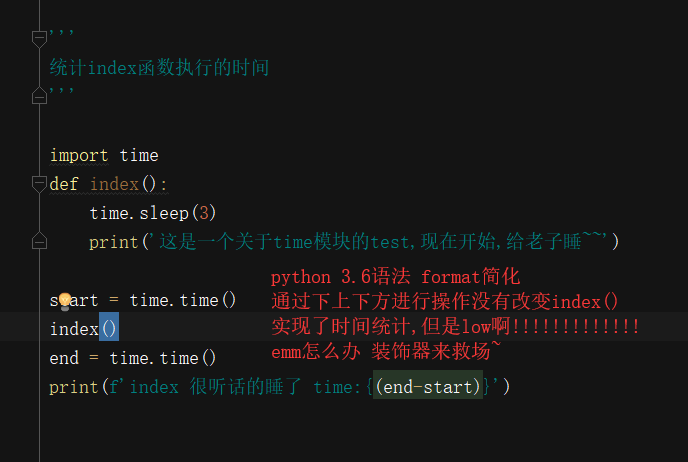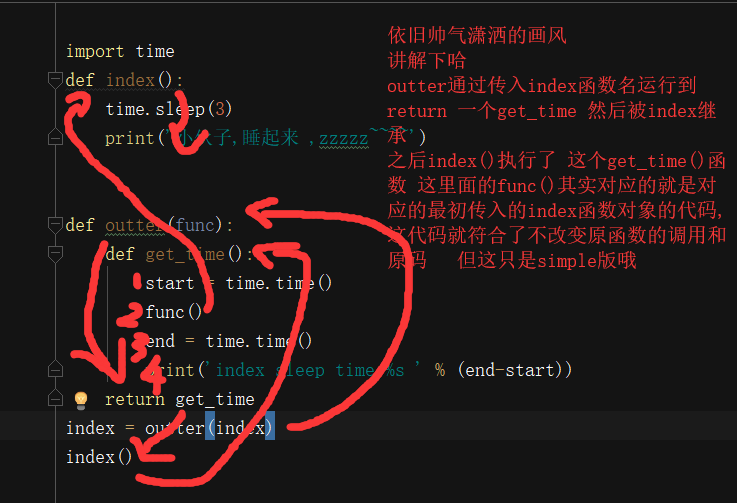闭包
闭包的定义
1.闭:定义在函数内部的函数
2.包:内部函数引用了外部函数作用域的名字
函数的参数传达
1.直接传参 def index1(username): print(username) 2.闭包来实现函数内参数传达 def outter(x,y): # x = 1 # y = 40 def my_max(): if x > y: return x+y return y return my_max res1 = outter(1, 40) print(res1) res2 = outter(90,200) print(res2())
闭包实例
import requests url1 = 'https://www.baidu.com' def my_ger(url): response = requests.get(url) if response.status_code == 200: print(len(response.text)) my_ger(url1) my_ger('https://www.baidu.com')

装饰器
装饰器定义
器指的是工具,而程序中的函数就是具备某一功能的工具,所以装饰器指的是为被装饰器对象添加额外功能。因此定义装饰器就是定义一个函数,只不过该函数的功能是用来为其他函数添加额外的功能。
需要注意的是:
装饰器本身其实是可以任意可调用的对象
被装饰的对象也可以是任意可调用的对象
装饰器的实现必须遵循两大原则:
不修改被装饰对象的源代码
不修改被装饰对象的调用方式
单函数的实现装饰器的效果(超low版本)

实现函数名为参数的闭包 (simple版本)

实现解决调用函数参数的不固定问题(正常版本)

在被装饰函数正上方,并且是单独一行写上@装饰器名 装饰糖
实现作用 实际为 装饰器函数的返回值(一般都是内层函数的函数名) = 装饰器函数(被装饰函数函数名)


装饰器模板

多层装饰器(包括传参案例)
'''多层装饰器''' import time user_dic = {'is_logth':None} def outter(func): def get_time(*args, **kwargs): start = time.time() res = func(*args, **kwargs) end = time.time() print(f'func run rime:{(end-start)}') return res return get_time def login_auth2(data_source, x, t): # data_source = 'file' def login_auth(func): # func = index def inner(*args, **kwargs): if user_dic['is_logth']: res = func(*args, **kwargs) return res else: if data_source == 'file': username = input('plesse input your username>>>:').strip() password = input('plesse input your password>>>:').strip() if username == 'jinpan' and password == '123': user_dic['is_logth'] = True print(func) res = func(*args, **kwargs) return res else: print('username or password error') elif data_source == 'Mysql': print('from Mysql') elif data_source == 'ldap': print('ldap') else: print("暂无该数据来源") return inner return login_auth @login_auth2('file',1,2) @outter def index(): time.sleep(1) print('index') return 'index' res = index() print(res)
装饰器修复器 -- wraps的用法
使用help() __name__ 方法对被装饰器对象时候恢复原有的名字和注释
''' 装饰器修复器---wraps用法 ''' from functools import wraps def outter(func): @wraps(func) def inner(*args, **kwargs): ''' 我是inner函数 :param args: :param kwargs: :return: ''' print('执行被装饰函数之前 你可以执行的操作') res = func(*args, **kwargs) print('执行被装饰函数之后 你可以执行的操作') return res return inner @outter def index(): """ 这是index函数 :return: """ pass print(index) print(help(index)) print(index.__name__) index() ''' 用户查看被装饰函数的函数名的时候查看到的就是被装饰函数本身 用户查看被装饰函数的函数名的时候查看到的就是被装饰函数注释 '''
装饰器的函数的加载和执行顺序
加载顺序自下到上
执行顺序自上到下
'''多层装饰器的练习案例''' def outter1(func1): print('加载了outter1') def wrapper1(*args,**kwargs): print('执行了wrapper1') res1 = func1(*args,**kwargs) return res1 return wrapper1 def outter2(func2): print('加载了outter2') def wrapper2(*args,**kwargs): print('执行了wrapper2') res2 = func2(*args,**kwargs) return res2 return wrapper2 def outter3(func3): print('加载了outter3') def wrapper3(*args,**kwargs): print('执行了wrapper3') res3 = func3(*args,**kwargs) return res3 return wrapper3 @outter1 @outter2 @outter3 def index(): print('from index') """ 加载了outter3 加载了outter2 加载了outter1 执行了wrapper1 执行了wrapper2 执行了wrapper3 from index """ index()